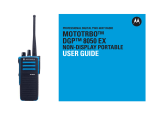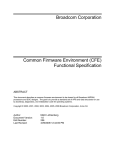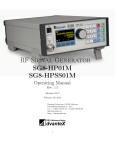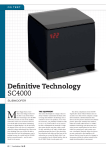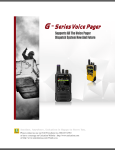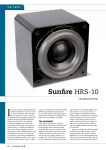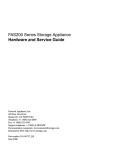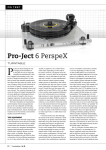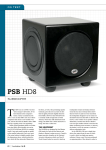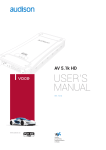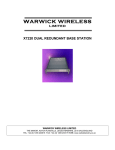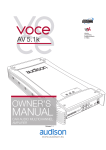Download Audison Bit Ten Processor Review
Transcript
68 Audison bit Ten and bit Ten D processors AUDITION Reviewer Marty Price The best processor is chopped in half. When talking audio systems most people know the basics. First you need a quality source, then a decent amplifier to get the sound loud and clear and finally a good set of speakers and a subwoofer to fill out the bottom octave. That should be it right? Well wrong actually. There are a few other things you should have and while sound deadening is perhaps the most important of these items commonly omitted when the budget gets tight, a processor is the other item which you should budget for. I’ve heard people say that if your speakers are good enough then you won’t require a processor. Sadly this isn’t the case because it’s the environment that creates the need for a processor, not the speakers. Regarding linearity; you have windows that reflect higher frequencies, dash boards that reflect lower frequencies, seats and interior parts that absorb differing frequencies of rarefaction and compression waves depending on their material (leather, vinyl, et al) and usually a massive suck-out in the response due to things like carpet – and that’s just the linearity. Then there is the staging and imaging of the sound that cannot be perfected without at least a little time alignment. This is where a processor comes in – they’re primarily designed to combat acoustic shortcomings and the difference they can make to a stereo must be heard to be believed. Processing Processors There are a plethora of processors on the market of varying quality levels but the current leader and arguably the best processor in the world is Audison’s bit One. It is the absolute pinnacle of processors and what it cannot do sonically is not worth knowing about. However like most serious processors its price tag is four figures. Seeing as Italian electronics giant Elettromedia (producer of Audison) is not only interested in producing the world’s best products but also catering for everyone, it invoked an idea that was born when the managing director of Elettromedia, one Pietro Petrolioni, made a worldwide trip on the back of the bit One’s massive success and asked dealers how Audison could improve it? The overwhelming answer, and indeed the one I had too, was they didn’t need to improve it but rather produce one with half the channels, all the abilities and half the price tag. Hence the concept of the bit Ten was born and finally in 2011 we see the arrival of two different variants; the analogue bit Ten and digital bit Ten D. Besides being advanced processing suites, the bit Ten is also a complex line level converter, designed specifically to interface with factory head units removing the need for you to purchase expensive dash kits, looms and steering wheel interfaces in order to install an aftermarket head unit. Just on this point; remember many current OEM source units are actually just as good a quality as aftermarket ones so far as DACs and other sound related components go. Both the bit Ten and bit Ten D have four channels of analogue input which can be configured as either standard front left/right and rear left/right, the more specialised tweeter and woofer or what I suspect we’ll see being used most; front left/right and subwoofer left/right – this is most common for staging reasons but more on this later. These can be attached to either the speaker wires of a factory deck or the RCA outputs of an aftermarket deck and the voltage difference is measured by the processor during the setup process. Being designed for the digital realm the bit Ten D also has an optical input. Both units have phone interrupt ability where you can input your phone kit’s speaker output wire, the bit Ten will mute the sound and start transmitting the person on the other end through your audio system. There is also an auto sensing turn-on switch meaning if you’re using a factory head unit without remote wire, you can allow the unit to power up upon sensing signal coming down the input wires. Next to the main loom plug there’s an additional auxiliary input meaning you can have your head unit as your master input and something like a game box feeding the auxiliary input. Turning to the outputs and whereas the bit One has eight separate RCA pre-outs the bit Ten and bit Ten D have five. These are fully programmable as to what they’re outputting and this is all set during the initial configuration stage. This is where the bit Ten D differs from the analogue bit Ten as it can accommodate and control the Audison Thesis amplifiers via two additional ports; the AC-Link and AD-Link. The Thesis and upcoming Voce series of amplifiers are not only fed eight channels of signal digitally via the AD-Link (aka Audison Digital Link) which is a CAT5. S cable with an RJ45 connector but they can be completely controlled via the AC-Link (aka Audison Control Link). These three additional ports (the optic input, AC-Link and AD-Link) are what differentiate the bit Ten D from the bit Ten. Those familiar with the bit One will know it comes with a digital remote control (or DRC) and although the bit Ten also has a DRC port they don’t come equipped with one from the factory which keeps costs down. Sound processing Moving to the actual processing of sound and we first need to take a step back and examine what it is we’re actually trying to achieve when we state the term ‘sound quality’. There are two main aspects that make up sound quality; firstly we want the car to stage and image correctly and secondly response needs to be linear and tuned to suit our ears. So far as stage and image goes we want the sound to be in front of us, much like when you go to a concert. The stage width should reach from mirror tip to mirror tip, the stage height should be at face-level while the stage depth should reach as far down the bonnet as possible. If achieved this doesn’t mean the music is miles in front of you but on the contrary you should have an ambience within the car to around 270 degrees. The pinna (the outer part of the ear visible on the side of one’s head) is a very directional device that faces forward and catches rarefaction and compression air waves which is what music essentially is differing frequencies of. When you think about it there are no band members behind you at a concert and most of the music you’ll listen to is going to be two channels or stereo. For these reasons we tend to omit rear speakers in sound quality cars (obviously this rule does not apply to surround sound with dedicated fourth and fifth channel information). But hopefully you’re starting to see now why those extra channels from the bit One were dropped as most people aren’t going to miss them. Then there is image; this is where we can close our eyes and actually point to where each band member is upon our dash. Not waving your hand around stating the singer is “somewhere here” but rather feeling that you can actually reach out and touch the singer’s face. Both stage and image are severely impeded by you sitting off to one side, you also have your leg in front of the right speaker, a steering wheel and binnacle in front of you causing all matter of issues too, and this is where the time delay portion of the bit Ten software comes in. You can set up alignment (or delay) in either time (up to 15ms in 0.02ms steps) or distance (up to 510cm) with the latter being switchable between metric (cm) or imperial (in). When used in conjunction with very careful speaker placement and angling, this allows you to achieve a perfectly central sound stage and image upon your dash board for when setup correctly you shouldn’t be able to tell where the speakers are located. The second part of sound quality is linearity and again we need to examine our ears. You’ve probably noticed by now the most peculiar shape of the pinna but again this wasn’t God having a little fun with you. The pinna is actually an extremely complex shape which is designed to trap, channel and basically funnel air waves into your outer ear canal where it is then forwarded to the ear drum for processing. The pinna is most sensitive to frequencies between the 2kHz and 5kHz region and can often hear beyond the 15kHz region depending on shape, size and angle, etc. On the other end of the sound spectrum; although our ears start to lose their ability to accurately hear around the 30Hz – 100Hz region we also feel bass so we can interpret sound and music right down to around 2Hz – 3Hz where it just goes right through us. Seeing as your ear is most sensitive to those upper midrange frequencies you can see immediately that tuning your car to a flat response is going to overemphasize those frequencies. Therefore we tune the car to a response curve which is the diametrically opposed to what our ears are most sensitive to. In other words linear from 20kHz down to 5Khz, then attenuated 1dB between 5Khz and 2kHz and then linear again for the lower frequency region. However cabin gain is another issue you’ll soon come up against and so you’ll find your midbass begins to rise (1dB gain is usually sufficient) around 200Hz and then it will lift further in the sub-bass region. The resulting curve is called a Fletcher-Munson curve and should be smooth and without any significant jolts in order for our ears to find it pleasant to listen to. Now at this point I should proclaim that this is not the be-all and end-all of tuning as you’ll still need to modify this FM curve to suit your personal tastes. But it’s just the logical response to start your customisation from. The real time analyzer is a sophisticated machine that can often be found in the best audio tuning shops and accurately measures frequencies at 1/3 octave points between 20Hz and 20kHz. In figure-1 we see what a standard response looks like when measured with the RTA – it’s terrible and contains many nasty peaks and dips. In figure two we see the FM curve we’re aiming for. Now if you were going to tune with your factory head unit then you probably have two or three bands. So you have bass spanning from 20Hz to 1kHz and treble from 10kHz to 20kHz. Good luck trying to smoothen your response curve. Even with more advanced aftermarket head units you still tend to have 5- or 7-band equalisers and while this can certainly make quite a noticeable difference (especially if parametric) it still cannot get a perfect response curve. If you’re wondering what the difference between parametric and graphic equalisation is; graphic tends to offer more bands but they’re fixed in both frequency and width whereas parametric tends to have less bands but you can set the frequency centre and adjust how wide the curve influence is (how much of the sound spectrum you adjust when you change any given frequency). This is where the bit Ten equaliser comes into play as it’s a full 1/3 octave 30-band equaliser meaning you can actually control each and every single band being displayed on that RTA completely separately to any others with an attenuation of down to -12dB to a boost of up to +12dB. Put simply; you can program any curve you want. Crossing over Moving to the crossover functionality of the software; the unit also has a complex system built-in and depending on what speakers you’ve designated when setting the unit up it can high-pass, low-pass or band-pass using ei- 69 AUDITION TECH SPECS Audison bit Ten and bit Ten D processors Type: Software-based processors with analogue only (bit Ten) or analogue/digital (bit Ten D) control Functions: Variable inputs and outputs (including digital on the bit Ten D), 31-band 1/3 octave equaliser, crossover, time-alignment, level adjustment, turn on/off delay, phone input and mute, digital remote control ready Cost: bit Ten $549, bit Ten D $849 Contact: Clarion Australia on 03 8558 1115 Web: www.audison.com • • • • Fully-featured Comprehensive configuration options Superb user interface Transforms any audio system • Left scratching head… corresponding response graph are clearly presented on the bottom portion of the right hand side. The bit Ten comes with an installation CD and all the hardware you need to install it on your PC and begin conversing with the unit via the USB cord supplied. About the only downside of the software is that it’s not Mac compatible. On the positive side though Audison do publish various free software updates meaning you can keep your bit Ten software up to the latest version as improvements are released. The USB on the bit Ten is version 2.0 just in case you’re interested. So far as build quality goes, the external appearance is just like the bit One; über smooth and professional-looking. The unit has a 176mm x 33mm x 120mm (not including mounting feet) steel case and is finished with a blend of coated flat black and dark grey. All inputs and outputs are clearly labeled and on the top are the large Audison and bit Ten logos. Beneath this on a sunken dark grey panel are the potentiometers for controlling input gain, phone kit gain and auxiliary gain. Adjacent to each is a warning light which alerts you if the signal is pushed into clipping. In another very clever innovation the bit Ten can be setup without a PC using these lights in conjunction with a very precise set of procedures. Removing the rear cover for a closer look at the internals, I should mention that the earth issue that bugged many past processors has now been resigned to the annals of history. Within the bit Ten is a 32-bit, 147mHz clock speed Cirrus Logic DSP. This DSP was designed specifically for Audison and ensures a high standard of integration via a system that sees the main processing functions pre-configured in blocks, meaning there is little impact on the software performance when it’s being utilised. In plain English, this means while you’re sitting in your car making changes you don’t have to wait ten seconds at a time to hear them! Also in there are 24-bit ADC and DAC convertors working in pulse code modulation of 48kHz and just to top off the superior design, there is a very powerful microcontroller interface to ensure superior speed, performance and less crashes when connected to a PC – something which I for one am looking forward to because don’t some processors get touchy if you don’t connect to them in a very specific way? The rest of the components used within are all high quality and this is reflected in the way the unit sounds, adding very little distortion (try 0.005% THD), hiss or colouring to the sound as it processes it. Getting the unit into my car and connected I began by running through the setup JBL’s MS-8 has again similar features, comes with a small display screen and headphones/microphones and on-board amplification for $999 Alpine’s now near-iconic Imprint, in its PXA-H100 iteration, has somewhat similar features with less inputs/outputs for $299 with a $99 microphone procedure. First step is to select what inputs you’re using (you can turn off those you’re not using). From there you then select what channels are going to be doing what, what speakers you have installed in your car and whether you have crossovers running or not (in the event of a full or semi-active system). From there you then tell the unit if you’re using any AC-Link amplifiers and then you’re onto level settings. The unit first measures your maximum undistorted voltage, and using a special sine-sweep track on the disc included, it then sets its own levels to match those of your source. It also has a very clever function where it can measure any equalisation your existing source has and can de-EQ your source, effectively flattening the input signal ready for you to start tuning. I spent an hour on our RTA tuning the car for an FM curve and then removing a little treble as is my personal taste. It’s always a little hard to explain the difference a processor makes to any system and often here we just put people into a car and hit the defeat button. Upon doing this the music goes from being rich, centred and full to be somewhat tinny, airy and basically at the peril of the cars materials. Believe me; even if your speakers are worth a mint, they’re still in a car interior – processing is a must. SIGNIFICANT OTHERS 70 ther Linkwitz or Butterworth roll-off logarithms (handy for on-axis/off-axis situations) and can offer any frequency step between 20Hz and 20kHz. So far as slopes go, you can choose anything between 6dB and 24dB per octave. Although those are the main abilities of the processor it doesn’t end there. There are two presets meaning you can program your central time alignment and FM curve into preset-A and then experiment with preset-B, just restoring it from A if you stuff it up completely. Alternatively you might have one setting for hard music, one for soft, one setting for you and one for your wife, one for a good day at work and one for a bad day at work – you get the picture. There are also various level settings meaning you can set individual levels on both left and right which is handy if your amplifier has separate gain pots which are not overly sensitive. There’s also a flatten option to defeat the EQ and a phase inversion switch if you wish to change any of your speakers. There’s also a left/right link option so you can actually separate the controls completely from one another if you want independent left and right hand channel controls. Last but not least there’s a really cool little operation that has been incorporated into the software that allows you to set the startup and shutdown delay time in milliseconds. Moving from the abilities to the actual software interface itself; I’ve used a fair few processors over the years and this is easily the most user friendly design I’ve seen to date ergonomically speaking. Its layout is clear, user friendly and most easy to follow with the schematic diagram and channel map on the left hand side, time alignment, crossovers and levels on the top half of the right hand side. The equaliser, its 31 virtual sliders and the O I N I Z N O E L B A L NOW AVAI c a M / C P & id o r for iPad, And TOUCH US PINCH US WE’VE ALL GONE DIGITAL SOUND+IMAGE AUSTRALIAN HI-FI GEARE CAMERA PRO PHOTO AUSTRALIAN INCAR ENTERTAINMENT Find the special three-issue ZINIO SUBSCRIPTION RATES at AVHub.com.au and www.zinio.com/InCar IN Conclusion Audison has basically taken the multi-award winning bit One, chopped it in half and presented the world with the bit Ten and bit Ten D models. What a shame it wasn’t as easy as that because we would have seen these two diminutive processors years ago but rest assured the wait has been well worth it. Try one in your car and if it doesn’t make an absolute world of difference, I’ll eat my bandana. Te S PHer Iew TO N rV cHrIS la NO eS N SPOTIFY is here! N TIBmurTON lweISemaN JamamerO But is it hi-fi? c AustrAliA’s A A’s No.1 AV Guide Aug/Sep 2012 REVIEWED Manley Chinook Phono Preamp Details inside p11 Usher Audio S-520 Bookshelf Speakers Unison Research S6 Integrated Amplifier D’Agostino Momentum Monobloc Power Amps B.M.C. BCCD1 & DAC1 CD Player & DAC/Pre MK Sound SB1250 Subwoofer Full reVIewS Top TVs On Trial Loewe • Panasonic VT50 & ST50 • Samsung plasma & LED • Sony HX850 $8 avhub.com.au NZ$ SPeaker PackS THE ITALIAN JOB Single-ended Single-ended Singleended Clas Class-A valve design improved by user bias calibration MK SOUND SB1250 We test this hugely powerful subwoofer! ORT BRISTOL 2012 SHOW REP Jul/Aug 2012 $7.95 AVHUB.COM.AU



